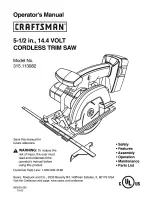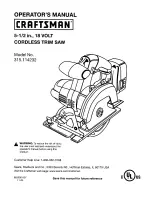
7-1/4 in. Circular Saw with Laser
6
For technical questions call: 1-800-665-8685
V 3.03
8340481
4. If the blade is binding, or if interrupting a cut for any reason, release the trigger switch and
hold the saw motionless in the material until the blade comes to a complete stop. Never
attempt to remove the saw from the workpiece or pull the saw backward while the blade is in
motion or kickback may occur. Investigate and take corrective actions to eliminate the cause
of blade binding.
5. When restarting a saw in the workpiece, centre the saw blade in the kerf and ensure that the
saw blade teeth are not touching the material. If the saw blade is binding, it may walk up or
kickback from the workpiece when the saw is restarted.
6. Support large panels to minimize the risk of blade pinching and kickback. Large panels tend
to sag under their own weight. Supports must be placed under both sides of the panel near
the cut line, and near the edge of the panel. If the cutting operation requires you to rest
the saw on the workpiece, rest the saw on the largest portion of the material and allow the
smaller piece to drop-off – this will help to reduce the risk of blade pinching and kickback.
7. Use extra caution when making a “plunge cut” into existing walls or other blind areas. The
protruding blade may unexpectedly cut into unseen objects that could cause kickback.
8. Only use blades that are designed for this tool. Keep blades sharp and clean, and never use
dull or damaged blades. Unsharpened or improperly set blades produce a narrow kerf and
cause excessive friction, blade binding, and kickback. Gum and wood-pitch hardened on the
blades will slow the saw and will increase the potential for kickback.
9. Never force the saw. Forcing the saw can cause uneven cuts, loss of accuracy, and possible
kickback. Push the saw forward at a speed that allows the blade to cut without slowing.
VIBRATION PRECAUTIONS
This tool vibrates during use. Repeated or long-term exposure to vibration may cause temporary or
permanent physical injury, particularly to the hands, arms, and shoulders.
1. Anyone using vibrating tools regularly, or for an extended period, should first be examined
by a doctor and should then have regular medical check-ups to ensure that medical problems
are not being caused by, or worsened from, tool use. Pregnant women or people who have
impaired blood circulation to the hands, past hand injuries, nervous system disorders,
diabetes, or Raynaud’s Disease should not use this tool. If you feel any medical symptoms
related to vibration (such as tingling, numbness, and white or blue fingers), seek medical
attention as soon as possible.
2. Do not smoke during use. Nicotine reduces blood flow to the hands and fingers and
increases the risk of vibration-related injury.
3. Wear suitable gloves to reduce the effects of vibration on the user.
4. Use tools with the lowest amount of vibration when there is a choice between
different processes.
5. Do not use for extended periods. Take frequent breaks when using this tool.
6. Let the tool do the work. Grip the tool as lightly as possible (while still maintaining safe
control of it).
7. To reduce vibration, maintain the tool as explained in this manual. If abnormal vibrations
occur, stop using this tool immediately.







































